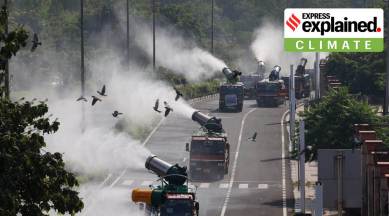Cleanest day-after-Diwali air in Delhi since 2015: how did this happen?
Delhi air pollution: Essentially the fact that it was windy; also that Diwali came early this year, and it wasn't cool enough. Both these are important factors; also, stubble-burning had a lower impact this year.

The day-after-Diwali air quality in Delhi was the best in the last seven years on Tuesday (October 25). This includes 2020 and 2021, the two pandemic years.
How was Delhi’s air on Tuesday?
The AQI (air quality index) was 303 on Tuesday, according to data from the Central Pollution Control Board (CPCB). It was 312 on Monday, Diwali day. This means the air was in the ‘very poor’ category on both days. AQI between 301 and 400 is considered to be ‘very poor’.
Still, the AQI this Diwali was the best the city has had since 2019. And the day-after AQI was the best since 2015.
According to CPCB data, the worst post-Diwali air quality in Delhi since 2015 was seen last year, when an AQI of 462 was recorded on the day after Diwali. This placed the air pollution in the ‘severe’ category. The AQI on Diwali day last year was 382. In four of the eight years since 2015, air quality has fallen to ‘severe’ the day after Diwali in Delhi.
Why was the air cleaner on Tuesday?
Meteorological conditions, essentially.
It was windy on Diwali day, and Gufran Beig, founder project director, SAFAR, said that wind speed helped prevent the accumulation of pollutants. Also, an early Diwali this year has meant that it is not yet cool enough for the air to trap pollutants in the lower layers.
“Wind speed picked up around 2 am on Tuesday. In the early hours of the morning, pollutants would have normally accumulated, when the temperature is cooler and the boundary layer comes down and winds become slower. But the wind speed picked up, aiding dispersion. The highest AQI levels were recorded around midnight, after which it improved and settled at 323 in the morning,” Beig said.
And what about pollution from stubble-burning in Punjab?
The contribution of crop residue burning in Punjab and Haryana has also been low so far this year. The wind direction, which has been from the westerly-southwesterly direction of Delhi since Monday, has not been favourable to transport stubble burning smoke from the northwest, Beig said.
According to an update issued by the SAFAR forecasting system, the share of stubble burning to PM2.5 levels in Delhi was around 5.6% on Tuesday. In contrast, the contribution of stubble burning to Delhi’s air on Diwali day (November 4) last year was 25%, and 36% on the day after Diwali, according to data from SAFAR.
According to data from the Indian Agricultural Research Institute, 5,798 crop residue burning events have been recorded in Punjab from September 15 to October 25. This is lower than the figure of 6,134 recorded till October 25 last year.
Is it that people also burnt fewer crackers this year?
It could be — even though anecdotal evidence suggests this may not have been true in many parts of the capital and the NCR.
Beig said: “It appears that there may have been a reduction in firecracker emissions compared to last year. The air quality did not deteriorate as much as it could have. But the contribution of firecrackers to the emission load is still unknown and could take a few days to determine.”
He said that some control measures may have worked. “It may be that people opted for firecrackers which release fewer toxic fumes though they produce sound.”
What do other experts say?
Sachchida Nand Tripathi, Professor at IIT Kanpur, said: “Crop residue burning has also not intensified compared to previous years. Additionally, lower temperatures would make the boundary layer thinner and would not allow particulate matter to disperse quickly. But the strong wind has offset this.”
Anumita Roychowdhury, executive director, research and advocacy, Centre for Science and Environment, pointed to a combination of factors. “Diwali has happened early, with warmer weather and much before the intense inversion conditions set in. Comparatively, there have been better wind speeds and crop fires have also not been as intense. It’s difficult to assess if there were reduced firecracker emissions,” she said.